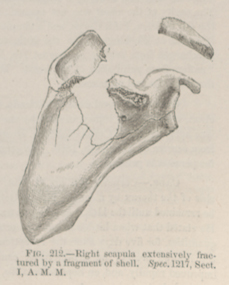Title: T——, F.
Source text: Surgeon General Joseph K. Barnes, United States Army, The Medical and Surgical History of the War of the Rebellion. (1861–65.), Part 1, Volume 2 (Washington, D.C.: Government Printing Office, 1870), 475.
Civil War Washington ID: med.d1e19204
TEI/XML: med.d1e19204.xml
CASE.—Private F. T——, Co. D, 5th New Jersey Volunteers, aged 46 years, was admitted to Carver Hospital, Washington, on May 9th, 1863. He had been wounded, on the 3d, at the battle of Chancellorsville. The shock to the system had been very severe. He was conveyed to the 1st division hospital of the Third Corps, and his wound, attended by great laceration of the soft parts, was dressed under the direction of Surgeon J. S. Jamieson, 86th New York Volunteers. When he rallied he was sent to Washington on an hospital transport steamer. A fragment of shell had struck the back, over the right scapula, causing a compound comminuted fracture. The wound was closed with sutures, and a linseed poultice applied; the patient was allowed sixteen ounces of wine in the twenty-four hours, and half diet. Brandy and quinia were subsequently prescribed. Death occurred on May 12th, 1863. At the autopsy, the tissues surrounding the wound were found to be involved to a very considerable extent; serous effusion had taken place, and a collection of pus was found below the neck of the scapula. The extent of the injury to the bone is shown in the adjoining wood-cut (FIG. 212). The spine and a large portion of the dorsum of the scapula are carried away, and a fissure extends into the glenoid cavity. The extremity of the acromion process, separated from its attachments, is present, but is misplaced in the cut. The specimen was contributed to the Army Medical Museum, with the history, by Surgeon O. A. Judson, U. S. V.
